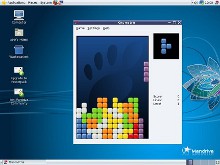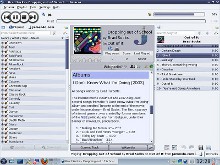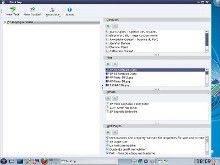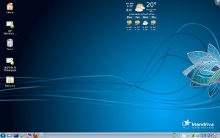Mandriva fights through money woes, releases 2010 Spring distro
Jul 9, 2010 — by Eric Brown — from the LinuxDevices Archive — viewsReprieved from its financial troubles with fresh investments, Mandriva released the final version of Mandriva Linux 2010 Spring. The latest stable release is touted for offering faster boot times, enhanced “Smart Desktop” file-organization technology, easier printer and wireless configuration, new scientific apps, plus updates including GNOME 2.30.1, KDE 4.4.3, and the new Go-OO branch of OpenOffice.
The delayed, July release of the biannual Mandriva Linux desktop distro, which shipped in its initial 2010 fall release last November and in a 2009 spring release in April 2009, appears to stem in part from Mandriva's troubled financial situation.
In May, the Paris, France-based firm, which calls itself "the leading European publisher of Linux solutions," announced it was up for sale due to a deteriorating financial situation. On June 23, as reported by The H, drawing from a story in LeMagIT, Mandriva announced it was staying intact with the help of new investments from undisclosed sources.


Mandriva Linux 2010 Spring with its GNOME 2.30.1 desktop (left) and KDE 4.4.3 (right)
(Click on either to enlarge)
Based on the 2.6.33 Linux kernel, Mandriva Linux 2010 Spring is touted as being faster to boot, although no firm claims were made in this regard. (Last year's spring release was said to offer a 25 percent improvement in boot times.)
The release offers a choice of GNOME 2.30.1, KDE 4.4.3, and LXDE desktops, with the former supplying a preview version of the new GNOME shell, which will debut in GNOME 3.0. The latest version offered by the GNOME project, release 2.30.1 also offers Pitivi 0.13.4 (video editing), a new version of Tomboy that can sync notes with the Snowy web service, as well as Empathy as the default IM client, replacing Pidgin.
The KDE 4.4.3 desktop is two baby steps behind the latest 4.4.5 version announced on June 30, but it's a substantial upgrade from Mandriva's earlier KDE 4.2.2. The desktop offers better Nepomuk integration, Amarok 2.3.1, KMess MSN Live IM 2.0.3., KOffice 2.2.0, and Digikam 1.3.0, says Mandriva. Other features are said to include KDE 3 data migration, an hourly background image switch, and Skrooge replacing Kmymoney2.
Mandriva 2010 Spring also offers updates including X.org Server 1.7.7, VirtualBox 3.1.8, and Firefox 3.6.6, says Mandriva. In addition, the spring release is said to supply the Go-OO branch of the OpenOffice office suite, adding SVG support, 3D transitions, VBA support, and KDE 4 integration.


Mandriva's updated Smart Desktop file management feature (left) and the main screen for the commercial PowerPack version
(Click on either to enlarge)
Mandriva users can now choose between three themes, as well a number of wallpaper selections, says the company. In addition, the Mandriva Control Center has been updated for easier setup, with easier configuration of printers and wireless modems, including Wi-Fi and 3G devices, says Mandriva. The RPMDrake package manager is said to offer access to more than 20,000 software packages.
As in previous versions, Mandriva provides a built-in firewall for improved security, and parental control features have been improved, says the company. Other highlighted features include Mandriva Directory Server (MDS), an "easy-to-use" LDAP directory manager. In addition, educational and scientific applications have been added, including Axiom (scientific computing), Jmol (a tool for visualizing molecules), and Salome (a generic platform for pre- and post-processing for numerical simulation).
Major applications in Mandriva Linux 2010 Spring's extra-cost Powerpack version include:
- Mozilla Firefox 3.6.6
- OpenOffice.org 3.2
- Moovida
- FileZilla 3.3.3
- Skype 2.1.0.81
- Opera
- Chromium
- Flash Player 10.1.53.64
- GCompris 9.2
- Acrobat Reader 9.3.3
- VirtualBox 3.1.8
- VMWare Player 2.5.3
Stated Arnaud Laprévote, Mandriva CTO, "Mandriva Linux 2010 Spring was conceived, produced and tested with our users. We are proud today to present this new version of Mandriva Linux. Ergonomic and fast altogether, Mandriva Linux 2010 Spring is the continuity of previous versions."
Availability
All three version of Mandriva Linux 2010 Spring are available now. Mandriva Linux 2010 Spring Free and One can be downloaded here.
The Mandriva Linux Powerpack 2010 slim pack version (containing the DVD, but no paper documentation) is available for 59 Euros ($69). The full Powerpack subscription, allowing Powerpack download access for twelve months (two Mandriva Linux releases), is available for 69 Euros ($79).
The Mandriva 2010 Spring announcement may be found here, the overview should be here, and the release notes may be found here.
The June 23 report in The H on Mandriva's new investments may be found here.
This article was originally published on LinuxDevices.com and has been donated to the open source community by QuinStreet Inc. Please visit LinuxToday.com for up-to-date news and articles about Linux and open source.